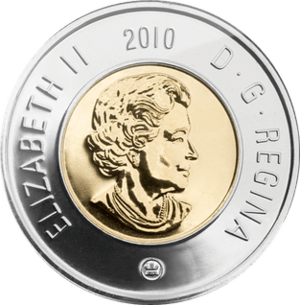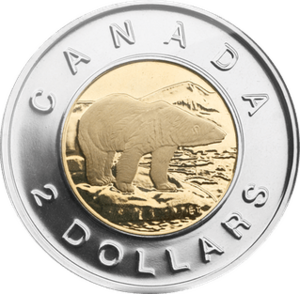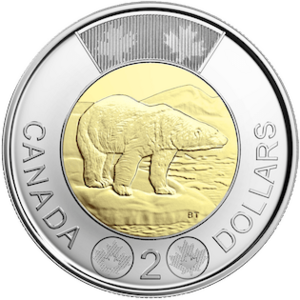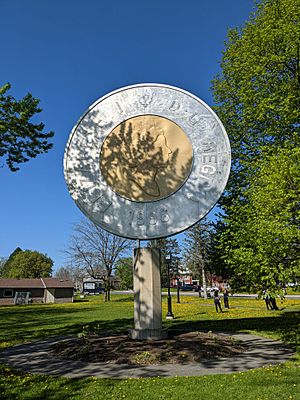Toonie facts for kids
| Canada | |
| Value | 2.00 CAD |
|---|---|
| Mass | 6.92 g |
| Diameter | 28 mm |
| Thickness | 1.75 mm |
| Edge | Intermittent milled/smooth |
| Composition | |
| Years of minting | 1996–present |
| Catalog number | - |
| Obverse | |
 |
|
| Design | Elizabeth II, Queen of Canada |
| Designer | Susanna Blunt |
| Design date | 2003 |
| Reverse | |
 |
|
| Design | Polar bear in early summer on an ice floe |
| Designer | Brent Townsend |
| Design date | 1996 |
| Design discontinued | 2012 |
 |
|
| Design | Polar bear in early summer on an ice floe |
| Designer | Brent Townsend |
| Design date | 2012 |
The toonie is Canada's two-dollar coin. It was first released on February 19, 1996. As of 2023, it's the coin with the highest value that is used every day in Canada. The toonie is special because it's made of two different metals. On one side, called the reverse, it shows a polar bear designed by artist Brent Townsend. On the other side, called the obverse, it has a picture of Queen Elizabeth II, just like other Canadian coins. The words on the coin, "ELIZABETH II / D.G. REGINA," are written in a unique style.
This coin is made using a special way of locking the two metal parts together. Toonies are expected to last about 20 years. Before the toonie, Canada used a two-dollar paper bill, which only lasted about one year.
In 2012, the Royal Canadian Mint (RCM) announced new designs for both the toonie and the one-dollar coin (the loonie). These new designs included special features to make them harder to copy.
Older toonies (made before 2012) had an inner part made of aluminum bronze and an outer ring of pure nickel. But from March to May 2012, the way they were made changed. The inner part became aluminum bronze with a brass coating, and the outer ring became steel with a nickel coating. The coin also became a bit lighter and thinner. The Mint said that using steel makes the coins harder to fake and helps save money.
Contents
What's in a Name? The Toonie Story
The name "toonie" is a fun mix of the word "two" and "loonie," which is the name for Canada's one-dollar coin. You might sometimes see it spelled "twonie" or "twoonie," but the official spelling used by Canadian newspapers and the Royal Canadian Mint is "toonie."
A politician from the area that is now Nunavut, Jack Anawak, suggested calling the coin "Nanuq." This is the Inuit word for polar bear and would have honored the Inuit people and their northern culture. However, most people preferred the name "toonie."
The name "toonie" became so popular that in 2006, the Royal Canadian Mint officially claimed the rights to it. There was even a contest to name the polar bear on the coin, and the winning name was "Churchill." This name is a nod to both Winston Churchill and the many polar bears seen in Churchill, Manitoba.
How the Toonie Began
In 1995, the Finance Minister, Paul Martin, announced that the two-dollar paper bill would be replaced by a coin. The Royal Canadian Mint spent money to ask 2,000 Canadian families what they thought of 10 different ideas for the new coin.
The Royal Canadian Mint's engineering team, led by Hieu C. Truong, designed the two-dollar coin to be made from two different metals. They wanted the coin to be lighter and thinner than other similar coins around the world. To put the two parts together, they used a special locking system. By the end of 1996, they had made 375 million toonies! The coin was officially launched in Montreal on February 19, 1996.
The town of Campbellford, Ontario, where the coin's designer lived, built a giant toonie monument that is 8 meters (about 26 feet) tall. It's similar to other big coin monuments in Canada.
Unlike the loonie, which was made at the same time as the one-dollar bill for a while, the two-dollar bill was stopped just three days before the toonie was introduced.
Special Toonie Designs: Commemorative Editions
The Royal Canadian Mint often releases special toonies to celebrate important events or anniversaries. These are called "commemorative editions." Here are some of them:
| Year | Theme | Artist | Number Made | Notes |
|---|---|---|---|---|
| 1999 | The founding of Nunavut | G. Arnaktavyok | 25,130,000 | This coin celebrated the creation of Nunavut and showed an Inuit drummer. |
| 2000 | Knowledge/Le Savoir | Tony Bianco | 29,880,000 | This was a Millennium edition. It showed three polar bears, and the words "2 DOLLARS" were on the front instead of the back. |
| 2006 | Churchill, 10th anniversary of $2 coin | Tony Bianco | 5,005,000 | This coin showed the bear looking up at the aurora borealis (Northern Lights). It was the first coin with a new mintmark. |
| 2008 | Québec, 400th anniversary of founding of Quebec City | Genevieve Bertrand | 6,010,000 | This design featured a large fleur-de-lis (a French symbol), a ship, and lines representing the St. Lawrence River. |
| 2011 | Boreal Forest, honouring Canada's boreal forest dedicated to the centennial of Parks Canada. | Nolin BBDO Montreal | 5,000,000 | This coin celebrated Canada's huge boreal forest. It showed three trees, a bird, and a person. |
| 2012 | War of 1812: HMS Shannon | Bonnie Ross | 5,000,000 | Part of a series about the War of 1812. It showed the ship HMS Shannon. |
| 2014 | Wait for Me Daddy | Claude Dettloff | 5,000,000 | Inspired by a famous photo from 1940 called Wait for Me, Daddy. |
| 2015 | 200th anniversary of the birth of John A. Macdonald | Glen Green | 5,000,000 | This coin featured a picture of Canada's first Prime Minister, John A. Macdonald, over a map of Canada. |
| 2015 | 100th anniversary of the poem "In Flanders Fields" | Glen Loates | 5,000,000 | This coin showed John McCrae writing his famous poem in a field of poppies. |
| 2016 | 75th anniversary of the Battle of the Atlantic | Yves Bérubé | 5,000,000 | This coin showed a sailor on a Canadian warship looking for threats in the sky. |
| 2017 | Canada 150 | Timothy Hsia | 10,000,000 | This coin celebrated Canada's 150th birthday. It showed paddlers under the glowing aurora borealis (Northern Lights). The aurora part actually glows in the dark! |
| 2017 | 100th anniversary of the Battle of Vimy Ridge | Tony Bianco | 5,130,000 | This coin featured the Canadian National Vimy Memorial in France, with soldiers from World War I. |
| 2018 | 100th anniversary of the end of World War I | Laurie McGaw |
|
This coin showed a soldier's helmet and a large poppy, which is a symbol of remembrance. Some coins had a red poppy. |
| 2019 | 75th anniversary of the Battle of Normandy | Alan Daniel |
|
This coin showed Canadian soldiers on their way to Juno Beach during World War II. |
| 2020 | 100th anniversary of the birth of artist Bill Reid | Bill Reid |
|
This coin celebrated the famous Haida artist Bill Reid and featured his grizzly bear design. |
| 2020 | 75th anniversary of the end of World War II | Thomas Shingles |
|
This coin marked 75 years since the end of World War II. It had a large "V" for Victory, a torch, and maple leaves. Some coins had flames in orange and yellow. |
| 2021 | 100th anniversary of the discovery of insulin | Jesse Koreck |
|
This coin celebrated 100 years since insulin was discovered. It showed parts of the insulin molecule and scientific tools. |
| 2022 | 50th anniversary of the Summit Series | Joel Kimmel |
|
This coin celebrated 50 years since the famous Summit Series hockey games between Canada and the Soviet Union. It showed two hockey players. |
| 2022 | Honouring Queen Elizabeth II | Brent Townsend | 3,675,000 | This coin marked the end of Queen Elizabeth II's time as Queen. It had the usual polar bear design, but the outer ring was black, like a mourning band. |
| 2023 | National Indigenous Peoples Day | Megan Currie, Myrna Pokiak (Agnaviak) and Jennine Krauchi |
|
This coin celebrated National Indigenous Peoples Day. It featured three designs representing Inuit, Métis, and First Nations cultures. |
Special Toonie Sets: Young Animals
From 2010 to 2015, the Royal Canadian Mint made special two-dollar coins that showed different young animals on the back. These coins were only available in special six-coin sets.
| Year | Theme | Artist | Number Made | Set Price |
|---|---|---|---|---|
| 2010 | Young lynx | Christie Paquet | 15,000 | $49.95 |
| 2011 | Elk calf | Christie Paquet | 15,000 | $49.95 |
| 2012 | Wolf cubs | Emily Damstra | 15,000 | $49.95 |
| 2013 | Black bear cubs | Glen Loates | 17,500 | $49.95 |
| 2014 | Baby rabbits | Pierre Leduc | 17,500 | $49.95 |
| 2015 | Baby raccoons | Clinton Jammer | 15,000 | $49.95 |
Toonie Fun Fact: Separating the Metals
When the first toonies were made, some of them could come apart if they were hit very hard or frozen. Even though some people talked about this, the Royal Canadian Mint said it was very rare, happening only about once in 60 million coins. It's also important to know that trying to break apart a coin on purpose is not allowed.
See also
- Newfoundland 2-dollar coin (an older two-dollar coin from Newfoundland before it joined Canada)


